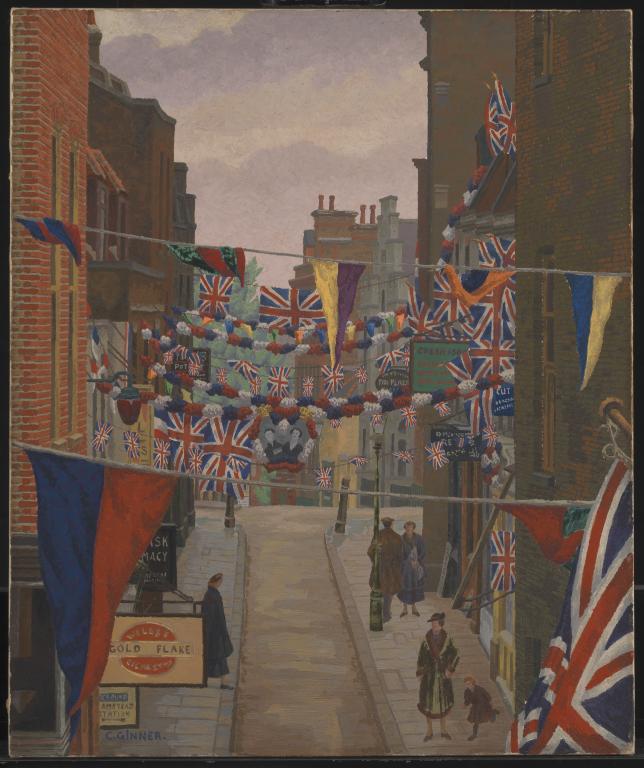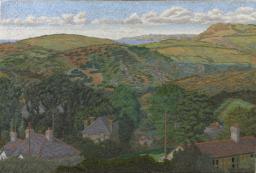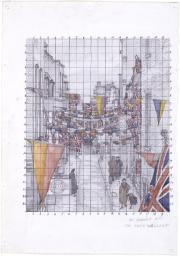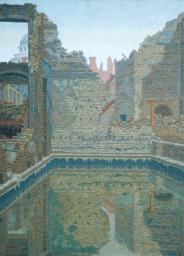Charles Ginner Flask Walk, Hampstead, on Coronation Day 1937
Charles Ginner,
Flask Walk, Hampstead, on Coronation Day
1937
Flags and bunting decorating Flask Walk in Hampstead, north London, commemorate the coronation of George VI on 12 May 1937. At a distance, an enlarged image of George and Queen Elizabeth hangs over the street; verdant trees from Hampstead Heath are visible in the background beyond.
Charles Ginner 1878–1952
Flask Walk, Hampstead, on Coronation Day
1937
Oil paint on canvas
610 x 508 mm
Inscribed ‘C. GINNER.’ in blue paint bottom left, and variously on notices and shop signs.
Purchased (Knapping Fund) 1941
N05276
1937
Oil paint on canvas
610 x 508 mm
Inscribed ‘C. GINNER.’ in blue paint bottom left, and variously on notices and shop signs.
Purchased (Knapping Fund) 1941
N05276
Ownership history
Purchased for 40 guineas (£42) from the artist via the Redfern Gallery, London, 1941.
Exhibition history
1937
Royal Institute of Oil Painters, London, October 1937 (343, £42).
1938
Cross-Section of English Painting 1938, Wildenstein, London, March–April 1938 (28).
1938
The 1938 International Exhibition of Paintings, Carnegie Institute, Pittsburgh, October–December 1938 (120).
1939
British Legion, Liège, 1939.
1942
The Tate Gallery’s Wartime Acquisitions, National Gallery, London, April–May 1942 (37).
1942–3
A Selection from the Tate Gallery’s Wartime Acquisitions, (Council for the Encouragement of Music and the Arts tour), Royal Exchange, London, July–August 1942, Cheltenham Art Gallery, September 1942, Ashmolean Museum, Oxford, October 1942, Galleries of Birmingham Society of Arts, November–December 1942, Fitzwilliam Museum, Cambridge, January–February 1943, Victoria Art Gallery, Bath, February–March 1943, National Museum of Wales, Cardiff, March–April 1943, Manchester City Art Gallery, April–May 1943, Philharmonic Hall, Liverpool, May–June 1943, National Gallery of Scotland, Edinburgh, June 1943, Glasgow Museum and Art Gallery, Kelvingrove, July 1943, Laing Art Gallery, Newcastle upon Tyne, August 1943 (18).
1946–7
Modern British Pictures from the Tate Gallery, (British Council tour), Palais des Beaux-Arts, Brussels, January–February 1946 (15), Stedelijk Museum, Amsterdam, March 1946 (15), Raadhushallen, Copenhagen, April–May 1946 (15, reproduced), Musée du Jeu de Paume, Paris, June–July 1946 (15), Musée des Beaux-Arts, Berne, August 1946 (14), Akademie der Bildenden Kunste, Vienna, September 1946 (14), Narodni Galerie, Prague, October–November 1946 (14), Muzeum Narodwe, Warsaw, November–December 1946 (14), Galleria d’Arte Moderna, Rome, January–February 1947 (14), Tate Gallery, London, May–September 1947 (5276).
1947–8
Modern British Pictures from the Tate Gallery, (Arts Council tour), Leicester Museum and Art Gallery, September–October 1947, Graves Art Gallery, Sheffield, October–November 1947, Birmingham City Museum and Art Gallery, November–December 1947, Bristol City Art Gallery, January–February 1948, Russell-Cotes Art Gallery, Bournemouth, February–March 1948, Brighton Art Gallery and Museum, March–April 1948, Plymouth Art Gallery, April–May 1948, Castle Museum, Nottingham, May–June1948, Huddersfield Museum and Art Gallery, June–July 1948, Aberdeen Art Gallery, July–August 1948, Salford Art Gallery and Museum, August–September 1948 (7).
1953–4
Charles Ginner 1878–1952, (Arts Council tour), Darlington Art Gallery, November 1953, Bristol Art Gallery, November–December 1953, Carlisle Art Gallery, January 1954, Tate Gallery, London, January–February 1954, Southampton Art Gallery, February–March 1954, Assembly House, Norwich, March–April 1954 (20).
1997
The Heath and Old Hampstead, Kenwood House, London, May–June 1997 (no number, reproduced).
References
1941
John Rothenstein, ‘The Tate Gallery, London, a Patron of Living Art’, Studio, vol.122, September 1941, p.63, reproduced.
1954
‘Charles Ginner. Memorial Exhibition at the Tate’, Times, 30 January 1954, p.8, reproduced p.12.
1960
Mervyn Levy, Drawing and Painting for Young People, London 1960, reproduced opposite p.97.
1964
Mary Chamot, Dennis Farr and Martin Butlin, Tate Gallery Catalogues: The Modern British Paintings, Drawings and Sculpture, vol.1, London 1964, pp.240–1.
1970
Malcolm Easton, ‘Charles Ginner: Viewing and Finding’, Apollo, vol.91, no.97, March 1970, p.208, reproduced fig.10.
1976
Alan Jenkins, The Thirties, London 1976, reproduced p.154.
2000
Wendy Baron, Perfect Moderns: A History of the Camden Town Group, Aldershot and Vermont 2000, p.175.
2006
Michael Lee, ‘Charles Ginner: Two Decades portraying Flask Walk’, in Michael Lee, Marianne Colloms and Ellen Emerson (eds.), Flask Walk N.W.3, London 2006, pp.39–41, reproduced p.40.
Technique and condition
Flask Walk, Hampstead, on Coronation Day is painted in artists’ oil paints on a commercially prepared canvas. The cloth appears to be fine plain-weave linen and bears the faint trace of an artists’ colourman stamp centred on the back. The distinctive oval format of the stamp matches that of a Reeves & Sons Prepared Canvas. The cloth appears to have been sized and primed with a white probably oil-based primer, which extends to the edges of the canvas and retains the canvas weave texture. It is attached to a four-member stretcher with coated steel tacks, which remain in their original positions. The dimensions of the canvas conform to a standard commercial size, historically known as ‘head size’ indicating that the support was purchased pre-stretched from the colourman. Like most of Ginner’s paintings, the canvas has planar distortions, due to the weight and the drying properties of the thick paint film. They are not particularly pronounced in this case, and have not resulted in structural problems, as they have in other of his works (see Tate N05306).
Ginner apparently used a home-made view-finder to aid in the composition of his pictures. It consisted of a rectangular cardboard frame measuring 110 x 90 mm, which was strung with black and white cotton threads to form a grid.1 The device relates directly to his preparatory drawings, which he habitually squared up with a black or sometimes red ink grid. There is no visible trace of any initial drawing beneath the paint film, although there is a squared-up preparatory study for the picture (Tate T01099). He would have carefully transferred the design from his drawing to the primed canvas in faint pencil, which would now be difficult to detect beneath the paint.2 The picture is painted with opaque mixtures of artists’ oil paints applied at a consistent viscosity, so that the dried paint retains the softened brush-marking. There are some variations in thickness and texture of paint across the canvas. Colour was applied in just one or two overlapping layers in the sky and worked rhythmically to give a sense of movement to the clouds. This produced a surface with less texture than the rest of the painting. In comparison, the accumulation of overlaid brushstrokes used to describe the decorations, figures and buildings produced a more layered and busily textured surface. In these areas, the paint is methodically built up in layers with minimum intermixing with underlying or adjacent paint even where painted wet-in-wet. Typical of this is the dark wall in the foreground on the right. The brickwork is underpainted in a relatively thin dark umber upon which the grid of mortar is painted and each brick then rendered with usually a single brush stroke of thick paint. This accumulation of detail upon detail produces a highly textured and intricate surface where each application of paint remains distinct. The paint film has localised areas of drying crackle, which are characteristic of Ginner’s work (see also Tate T03096). A thin film of varnish appears to have been applied but has been almost totally absorbed by the paint, suggesting that it was applied when the painting was partially dried and that there may be additional medium present that is compatible with the varnish (see also Tate N05306).
Roy Perry and Sarah Morgan
June 2006
Notes
How to cite
Roy Perry and Sarah Morgan, 'Technique and Condition', June 2006, in David Fraser Jenkins, ‘Flask Walk, Hampstead, on Coronation Day 1937 by Charles Ginner’, catalogue entry, May 2005, revised by Helena Bonett, February 2011, in Helena Bonett, Ysanne Holt, Jennifer Mundy (eds.), The Camden Town Group in Context, Tate Research Publication, May 2012, https://wwwEntry
The view is from the first-floor windows of Ginner’s house at 61 Hampstead High Street. It shows the decorations put up in the street opposite, Flask Walk, for the coronation of George VI on 12 May 1937. Ginner had moved to this house in 1919, occupying the four floors above the shop, but he painted the view most frequently just before he left in 1938, depicting the view on Guy Fawkes Day and under snow, both also in 1937.1 These views differ very slightly, perhaps because the room had three windows, but they also differ in focus. In the snow painting, Flask Walk is seen much closer, and it may be that Ginner used some kind of telescope.
The street signs are all partly cut off; they include on the left a notice for Hampstead Station Underground, Wills’s Gold Flake Cigarettes and Flask Pharmacy, and on the right the Flask Tavern, a butcher and Greens, an electrical shop. The Salvation Army hall is on the right. In the centre is a banner with an enlarged photograph of George VI and Queen Elizabeth. The preparatory drawing for this painting was given to the Tate Gallery in 1968 (Tate T01099, fig.1). The design is so detailed as to suggest that Ginner used some optical device. From observation and photographs of the street, it does not seem likely that he could have seen all that he includes from a single viewpoint.
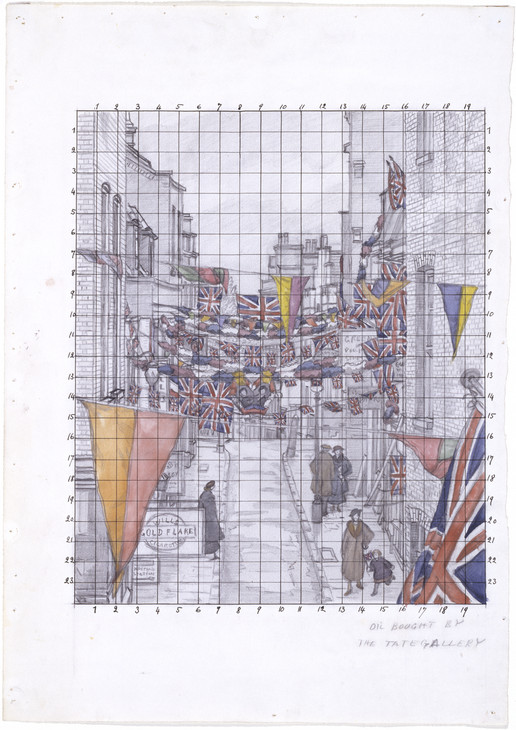
Charles Ginner 1878–1952
Study for 'Flask Walk, Hampstead, on Coronation Day' 1937
Graphite, watercolour and ink on paper
unconfirmed: 445 x 315 mm
Tate T01099
Presented by the Friends of the Tate Gallery 1968
© The estate of Charles Ginner
Fig.1
Charles Ginner
Study for 'Flask Walk, Hampstead, on Coronation Day' 1937
Tate T01099
© The estate of Charles Ginner
For perfect clarity in rendering the thing seen there is nothing better in the exhibition than Charles Ginner’s ‘Flask Walk’ (90). The view looking up this little street in Hampstead is in bright sunshine, and framed on either side between two of Mr. Ginner’s wonderful brick walls. The play of light and shade in the street, the delicate way in which the values are justly preserved right up to the glimpses of green trees in the distance, and the sense of movement in the little figures on the pavement and roadway, make up a whole that is as beautiful as it is true. It is a delightful fragment of contemporary life.9
The Times critic in 1954 concluded that despite Ginner’s realism, ‘the paintings seem to have been inspired not so much by the immediate contact with life as by intimations of nostalgia’, making Ginner ‘more a romantic than a realist’.10 The critic mentioned this painting as an example, and wrote that seeing it ‘bedecked with flags for the Coronation’ it was the art of L.S. Lowry that ‘comes to mind’.11
The art historian Malcolm Easton described the effect of colour and texture in this painting:
The windows of 61, Hampstead High Street overlook this little thoroughfare and the artist never tired of reproducing its many aspects. A black-and-white reproduction does it scant justice, all the same. Careful study of the original brings one closer to the genius of Ginner than that of any other work I know, the least promising elements in the task before him – the yellow-and-purple flag dead-centre, the red-white-and-blue paper-chains in conjunction with the green of the distant trees (the tray of his easel, owned by Mr Lock, is thickly spattered with this favourite viridian) – yielding the richest artistic dividends. Then there is the fine variety of texture woven by those idiosyncratic cow hair brushes of his: the herring-bone strokes in the sky, the long strokes receding to the vanishing-point of the far buildings and the brick-courses of the near building to the left raised solid above their ‘mortar’. Nor, in this instance, can one think less highly of the figures, for which in general he received few compliments.12
The depiction of deep perspective is remarkable, since the bunting and flags seen mostly head-on are at such varied distances, some extremely close. The bunting must have been part of the decorations running down Hampstead High Street, immediately in front of Ginner’s windows, as the rope runs on past the street entrance. The view is centred on the banner showing the new king and queen, though their grey colours hardly show against the flags. Ginner does not seem to have been especially royalist or conservative, so far as can be assumed from the subjects of his pictures and the recollections of friends. The coronation was a subject of great popular interest and public attitudes to the event at a time of national and international crisis became a theme for Mass Observation research. The painting itself is true to Ginner’s ‘Neo-Realist’ creed, and is a distant continuation of views of Paris streets with flags painted by Edouard Manet and Camille Pissarro. The emphasis, apart from the colour, is on four adults and a child walking the streets.
In Ginner’s second notebook this painting is titled both Flask Walk, 12 May 1937 and Coronation Day 1937.13 He lists the exhibition of 1939 at Liège, for which no catalogue has been found.
David Fraser Jenkins
May 2005
Revised by Helena Bonett
February 2011
Notes
Both reproduced in Benjamin Fairfax Hall, Paintings and Drawings by Harold Gilman and Charles Ginner in the Collection of Edward Le Bas, London 1965, as Flask Walk, November 5, pl.29 and Flask Walk, Winter, pl.30.
Watercolour, ink and gouache. Reproduced in Michael Lee, ‘Charles Ginner: Two Decades portraying Flask Walk’, in Michael Lee, Marianne Colloms and Ellen Emerson (eds.), Flask Walk N.W.3, London 2006, p.37.
Pen and ink and watercolour. Reproduced ibid., p.35. This version shows the window with curtain and a table and window ledge in the foreground with various objects.
Oil paint on canvas, 66 x 41 cm. Reproduced as in the collection of Edward Le Bas in John Rothenstein, Modern English Painters: Sickert to Smith, London 1952, pl.24, in between pp.176–7.
Oil paint on canvas. Reproduced at Aberdeen Art Gallery, http://www.aagm.co.uk/thecollections/objects/object/Flask-Walk--Skyline?l , accessed 4 February 2011.
Related biographies
Related catalogue entries
How to cite
David Fraser Jenkins, ‘Flask Walk, Hampstead, on Coronation Day 1937 by Charles Ginner’, catalogue entry, May 2005, revised by Helena Bonett, February 2011, in Helena Bonett, Ysanne Holt, Jennifer Mundy (eds.), The Camden Town Group in Context, Tate Research Publication, May 2012, https://www

